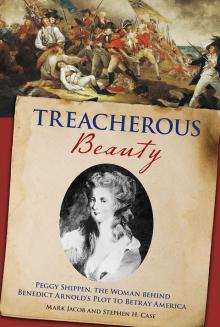- Home
- Stephen Case
Treacherous Beauty Page 4
Treacherous Beauty Read online
Page 4
Peggy Shippen as drawn by her friend John André. Hers was a life of high hair, high drama, and high treason. Portrait of Margaret Shippen (Mrs. Benedict Arnold), Yale University Art Gallery
Peggy Shippen was the youngest of the group, only seventeen when the British seized her city. Peggy Chew was about a year older, Becky Franks a year older still, and Becky Redman quite a bit beyond them, in her mid-twenties.
Peggy Shippen seems to have been the prettiest, though the dark-haired Peggy Chew was also described as quite beautiful. Chew, who was more the philosopher than her friend, once wrote: “What is life, in short, but one continued scene of pain and pleasure varied and chequered with black spots like the chessboard, only to set the fairer ones in a purer light?”87
Becky Redman was known as a lover of German music. Becky Franks, perhaps Peggy Shippen’s closest friend, was the mischievous and funny one, and an unabashed Loyalist. According to a story told early in the British occupation, a Continental Army officer once asked Franks whether she thought “their arms had not been crowned with great success” in the war, and she replied that she didn’t know about their arms, but she thought their legs had succeeded in running away.88
All four of the young women became enamored of an enthralling British officer who had recently been promoted to captain. His name was John André.
John André, poet, thespian, artist, soldier, and spymaster. The Art Archive, ref: AA532551
André was five-foot-nine, with dark hair and eyes, and olive skin inherited from his ancestors in the South of France. Just as people tended to dwell on Peggy Shippen’s physical attractiveness, men and women remarked on André’s fine features. A Connecticut militiaman once described André as “the handsomest man I ever laid eyes on.”89
But, like Peggy, John André was gifted on the inside as well. He spoke a cultured English, plus French, Italian, and German. He played the flute and sang. He danced superbly. He wrote and recited poetry. And he showed exceptional talent as an artist, drawing sketches of street scenes and portraits of his friends.90
He was twenty-seven, a decade older than Peggy, and his life experience was even further beyond hers. But his playfulness and youthful sense of wonder drew them close. He made regular pilgrimages to Peggy’s home on Fourth Street to discuss the arts and to flirt. He sketched a drawing of the young Peggy that is one of the few remaining images of her, with high hair, a headdress, wise eyes, and a Mona Lisa smile.
John André lavished attention on the other young women as well.
For Becky Franks, he painted a miniature portrait and wrote a few lines of poetry.91
At Becky Redman’s request, he cut silhouette portraits. He also wrote verses to her, set to her favorite German music, such as:
Return, enraptured hours,
When Delia’s heart was mine
When she with wreaths of flowers
My temples would entwine.92
He paid special attention to Peggy Chew, and if he loved any of them, she was probably the one. But he seemed to be fond of them all. And they of him.
Nothing about André was typical, including his path to the British army, and to America. Both his parents’ families were Huguenots, a sect of French Protestants who had suffered persecution. His paternal ancestors fled the South of France for safety in Genoa and Geneva. Eventually his father immigrated to London, where he became wealthy in the import business. He married a Parisian Huguenot, and they settled in a London suburb, raising their children—first John, then three daughters and another son.
André was instructed by a private tutor in his youth, then went to the Academy in Geneva where he mastered music, illustration, and other liberal arts that charmed so many of those he later encountered. He majored in mathematics and military drawing, and met other intellectuals such as Pierre-Eugene Du Simitiere, who would later befriend André in America and create the first design for the Great Seal of the United States, including the phrase “E Pluribus unum” (Out of many, one).93
André found that his father’s ambitions for him were not artistic in the least. Summoned home at age seventeen, André was put to work in his father’s counting house in London’s Warnford Court. About two years later his father died, leaving a will in which each of his five children inherited five thousand pounds (roughly nine hundred thousand dollars in today’s currency).94 However, the children would not get their money until age twenty-one, and as the oldest son, André was under pressure to support the family business.95
The summer after André’s father died, the family vacationed in Buxton Spa in Derbyshire. The spa, known as a sort of poor man’s Bath, offered springs that were said to heal, and sometimes to induce an “inebriating giddiness.” There André met a woman who would raise his intellectual game—Anna Seward, daughter of a clergyman then serving as canon of Lichfield Cathedral.96
Seward, a few years older than André, was a poetess known as the Swan of Lichfield. She and André became fast friends, and she brought him into her literary circle. She also guided his romantic interest toward her friend Honora Sneyd, a pretty seventeen-year-old girl who lived with the Sewards. Honora suffered from tuberculosis and also was afflicted with a shyness that made her more of a pet than a full partner in Seward’s group. Nonetheless, André was enraptured with Honora, and they became engaged. They were not allowed by their families to marry, however, unless André returned to London and established his business career first. André and Anna exchanged long letters, but Honora was not much of a correspondent, complaining that her illness made it difficult to write. She did, however, deign to add postscripts to Anna’s letters.
André resolved to endure the long-distance relationship and succeed at the family business. “When an impertinent conscience whispers in my ear that I am not of the right stuff for a merchant,” he wrote, “I draw my Honora’s picture from my bosom, and that sight of that dear talisman so inspirits my industry that no toil seems oppressive.”97
After a year living in London away from her, André returned to Lichfield for Christmas 1770 to find that Honora had developed a curious interest in an inventor and educational theorist named Richard Lovell Edgeworth, who was a married father of three. Rejected, André fled Lichfield. Edgeworth later wrote that “Miss Honora Sneyd was never much disappointed by the conclusion of this attachment.” But Edgeworth was hardly objective. After Edgeworth’s wife died in childbirth, he married Honora.98
And so the lover became a soldier. André, shattered by his disastrous romance, abandoned his father’s business and joined the Royal Welch Fusiliers as a second lieutenant. But it would be years before he saw any fighting. Partly because of his fluency in German, he was sent to a military training program associated with the University of Göttingen. As always, he made many friends, including poets in the Göttinger Hain literary movement, which promoted sentimental themes of nature, friendship, and love.99 And he kept up his art, painting portraits of the Duke and Duchess of Gotha.100
The vast stage for the drama of Peggy, Arnold, and André. At the time of the American Revolution, Vermont wasn’t a separate colony, nor was Maine. They’re included here for purposes of orientation. Illustration by Rick Tuma
Finally, in 1774, he was ordered to America to catch up with his regiment, which had already been sent to Quebec. He took an indirect route, arriving by ship in Philadelphia at the same time that colonial politicians gathered for the First Continental Congress, the event that occasioned George Washington’s dinner with the Shippens.
André found Philadelphia restive, and when a false rumor spread through the city that British warships had shelled Boston, André witnessed the potential for trouble in America—the gathering of angry, armed men in Philadelphia’s streets. Another inaccurate report indicated that André’s regiment had been sent to Boston, so André sailed there. He learned that his unit was still in Quebec, and it appears likely that he was h
appy to depart Boston, where the port was closed to merchant traffic, the citizens were agitated, and the British troops seemed either apathetic or oblivious to the gathering storm.101
André could have taken a ship straight to Quebec, but he chose an overland route. Some have speculated that André wanted to see the countryside because he was gathering intelligence for the British high command, but others say he was simply collecting intelligence for himself, filling notebooks with sketches and words about colorfully painted Indians, lush valleys, and rushing rivers, with the goal of someday writing a book. In any case, André sailed first to New York City and then up the Hudson River past Haverstraw, West Point, and other picturesque places that would figure prominently in his and Peggy Shippen’s story a few years later.
After disembarking at Albany, he walked to Lake George, hunting for small game along the way. Then on Lake Champlain he boarded a flat-bottomed boat called a bateau and traveled farther north, past Fort Ticonderoga in New York and Fort St. Jean in southwestern Quebec, two British outposts in rundown condition. From Montreal he traveled by schooner east on the St. Lawrence River to Quebec, wearing a bearskin robe to fight off the Canadian chill.102 “We had scarce any provision on board,” he wrote his sister Louisa, “and were clustered up, by way of keeping out of the cold, with a black woman, an Indian squaw in a blanket, an Indian boy, and the sailors round a stove in a dungeon-like part of the vessel.”103
Civilization awaited him in Quebec. He was invited to a fine ball thrown by the British commander in Canada, General Guy Carleton, and also enjoyed sleigh rides in the countryside with groups of friends, including ladies. “We dine, dance rondes, toss pancakes, make a noise and return, sometimes overturn, and sometimes are frostbit,” André wrote.104
He expected his regiment to be transferred to Boston or Montreal, but instead the Continental Army’s activity in northern New York kept him in place. In May 1775 colonial forces led by Ethan Allen and Benedict Arnold captured Fort Ticonderoga in a surprise attack. Arnold then raided Fort St. Jean, seizing a sloop with military supplies before being driven back.105 André’s regiment was sent to St. Jean and set to work improving the defenses. For a time, the most serious threat faced by André came from swarms of mosquitoes.
Suddenly the military life became more than fancy balls and sleigh rides for André. Two formidable colonial armies under Generals Arnold and Richard Montgomery headed north. Montgomery’s force laid siege to St. Jean, greatly outnumbering the British regulars and French Canadian volunteers. As the siege stretched from days into weeks, food ran short, volunteers deserted, soldiers lost limbs and lives, and no help arrived from Montreal. Montgomery’s cannon grew closer and more lethal.
André, keeping the official journal for the outpost, wrote that its buildings were steadily being reduced to rubble. The soldiers crowded into the basements to sleep, except for those “unable either to get a place or bear the heat and disagreeable smell arising from such members being crowded together.” The rest slept above ground, coping with the shelling, the chill, and the rain. Some simply wandered around the camp at night, unable to get any rest.
Finally Montgomery sent a blindfolded messenger, a Montreal hairdresser named Lacoste, to the British with the news that a force sent by Carleton to rescue Fort St. Jean had been beaten back. Further resistance was futile. The hairdresser had been part of the British relief force and spoke the truth, but the British doubted him, writing back to the colonials that Lacoste was “frequently subject to fits of insanity.” Montgomery offered to have a British officer talk with a more prominent Canadian who had witnessed the relief force’s defeat.
The British agreed, sending a blindfolded John André into the enemy’s lines. André was taken to the same sloop that Arnold had captured in his earlier raid, and after a short talk with the witness, he was convinced.
André and the rest of the British force surrendered.
Many years later, Anna Seward quoted André as writing at the time: “I have been taken prisoner by the Americans and stripped of every thing except the picture of Honora, which I concealed in my mouth. Preserving that, I yet think myself fortunate.”106 But that was a hackneyed bit of mythmaking by either André or, more likely, Seward. André kept his possessions, as demonstrated later when he showed his friend Du Simitiere the drawings he had made during his trek across New York.107
In fact, the captured Britons were treated exceptionally well, under rules for prisoners of war that appear absurdly genteel when compared to modern standards. Montgomery let the British officers keep their swords. And André and a few others were “paroled” so that they could go to Montreal and fetch the personal belongings of those captured. André and his fellow quartermasters returned to captivity with about twenty-two bateaux filled with possessions, thereby infuriating their colonial captors, who were much less well provisioned.
According to the terms of the surrender, the British troops would not be held at any prison camp. Rather, they would be assigned to rural colonial areas, to wait out the war, and would be banned from traveling outside their assigned districts. The officers were supposed to be held in Connecticut, with the enlisted men sent to Pennsylvania,108 but André never made it to Connecticut. He dawdled for nearly a month in Albany, making friends and providing dinner entertainment for an unlikely host: General Philip Schuyler, the Patriot general in overall command of northern New York. As André was preparing to leave Albany, the orders changed. The British officers would spend their captivity in Pennsylvania with their men. André was sent seventy-five miles west of Philadelphia to Lancaster, Pennsylvania, coincidentally the home of Peggy Shippen’s grandfather. The charming lieutenant headed down the Hudson in January 1776, enjoying a dinner in Haverstraw with a group that included attorney Joshua Hett Smith, who would later play a crucial role in the lives of both André and Peggy.
Most prisoners crossed the Delaware north of Philadelphia, some of them accompanied by their wives and children. André, drawn to places where people could appreciate his charm, went farther south to Philadelphia. His official reason was to talk with David Franks—Becky’s father—who had been hired by the British to supply André and the other prisoners with food and other necessities. Under the protocol of the time, the British government was responsible for supplying its soldiers who had been taken prisoner by the enemy, and vice versa.
In Philadelphia, while making arrangements with David Franks, André is believed to have first met Becky Franks. As he earned her admiration by giving her a miniature portrait and writing her some poetry, he also made the brief acquaintance of her friend Peggy Shippen.109
Then it was on to Lancaster, where he reported to authorities and promised not to stray more than six miles from the town or conduct any correspondence related to the war. Most Lancaster residents refused to lodge the British soldiers. Pennsylvanians who were British sympathizers did not want to appear to be so, while those who hated the British could not abide having them in their houses. Both Loyalists and Patriots could agree on one thing: Soldiers could be loutish, drunken guests who might pose a threat to the womenfolk. Some enlisted men were consigned to shabby old barracks, while officers such as André were billeted in local taverns, where they got into bitter disputes with the tavern owners over their rent.
André was more at ease interacting with the settlers, especially the Germans, who appreciated his fluency in their language. He and the other captured officers were eventually transferred even farther away from Philadelphia, to Carlisle, where André found the residents to be “a stubborn, illiberal crew called the Scotch-Irish.” Soldiers from Carlisle had suffered casualties in recent fighting in Quebec, and the locals took out their hostility on André and his fellow prisoners. For example, when André and a comrade were spotted talking to two suspected Tories, local authorities seized letters signed by André that seemed to be written in code. But the “code” was simply French, which no one in town could read. Even so
, André was then restricted to the streets of town, rather than allowed his initial six-mile radius.
In late November 1776 the Patriots, in need of manpower while retreating across New Jersey, engineered a prisoner exchange. André and other British captives were marched eastward, past retreating, disorganized elements of Washington’s army. All the while, André drew maps and carefully observed the enemy. In New Brunswick, New Jersey, he and his comrades were turned over to the main British army.110 Once in New York City, he wrote his mother: “You may conclude my carcass to be very safe for this winter, and, as I have some regard for myself, you may depend upon it.”111
Within the eighteenth-century British military structure, officers could purchase higher ranks, subject to approval, and upon his return André did so, rising from first lieutenant to captain. Again making use of his German language skills, André offered himself as a liaison to the growing number of Hessian troops arriving in America to augment His Majesty’s army.
André was appointed aide-de-camp to General Charles Grey, and in June 1777 he joined his new unit aboard a huge flotilla whose destination was top secret. Before leaving, André executed a will giving seven hundred pounds apiece to his brother and three sisters, plus smaller bequests to friends.
Many people on both sides of the conflict expected the British force, led by General William Howe, to sail up the Hudson and support General John Burgoyne’s army, which was invading southward from Canada. Instead, André and the rest of Howe’s force went south to Norfolk, Virginia, then up Chesapeake Bay, landing at its most northerly point and heading for the city where independence was born—Philadelphia. Washington’s effort to stop them south of Philadelphia led to the Battle of Brandywine, a British victory.112

 First Fleet #1-4: The Complete Saga
First Fleet #1-4: The Complete Saga Treacherous Beauty
Treacherous Beauty Beneath Ceaseless Skies #166
Beneath Ceaseless Skies #166 Beneath Ceaseless Skies #212
Beneath Ceaseless Skies #212 Beneath Ceaseless Skies #231
Beneath Ceaseless Skies #231